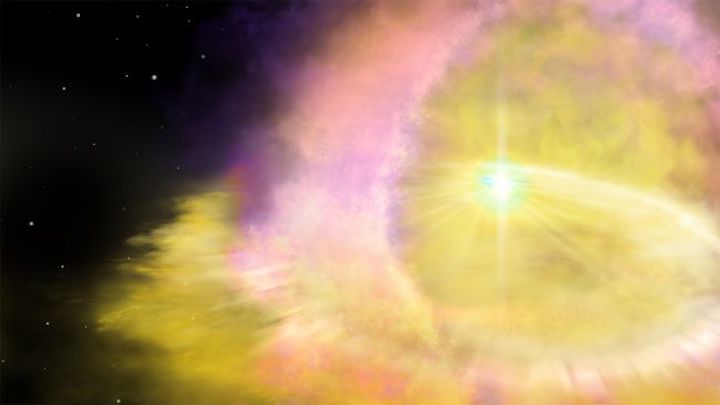26.08.2020
The fossil record suggests Earth's ozone layer took a protracted beating.

One of the worst extinction events in Earth's history may have been triggered by a supernova, the violent death of a distant star.
About 75% of all species on Earth died out at the end of the Devonian Period, nearly 360 million years ago. Rocks from this era preserve many thousands of spores that appear to be scorched by ultraviolet (UV) radiation, indicating that something went seriously wrong with our protective ozone layer.
The destructive force may have come from very far afield, a new study suggests.
"Earth-based catastrophes such as large-scale volcanism and global warming can destroy the ozone layer, too, but evidence for those is inconclusive for the time interval in question," lead author Brian Fields, a professor of physics and astronomy at the University of Illinois, Urbana-Champaign, said in a statement.
"Instead, we propose that one or more supernova explosions, about 65 light-years away from Earth, could have been responsible for the protracted loss of ozone," Fields said.
"To put this into perspective: One of the closest supernova threats today is from the star Betelgeuse, which is over 600 light-years away and well outside of the kill distance of 25 light-years," co-author Adrienne Ertel, a graduate student in Fields' research group, said in the same statement.
Death by exploding star?
Supernovas, which end the lives of giant stars like Betelgeuse, can hit Earth life with a powerful one-two punch. Highly energetic UV, X-ray and gamma radiation delivers the first wallop, and the second comes from swarms of charged particles called cosmic rays that are accelerated to tremendous speeds by the explosion. This combo can damage Earth's ozone layer for 100,000 years or so, study team members said.
Fossil evidence suggests that biodiversity decreased substantially for about 300,000 years at the end of the Devonian, which is often called "The Age of Fishes" because of its tremendous fish diversity. So the end-Devonian extinction may have involved several different dramatic events — perhaps two or more nearby supernova explosions.
"This is entirely possible," said study co-author Jesse Miller, another grad student in Fields' lab. "Massive stars usually occur in clusters with other massive stars, and other supernovae are likely to occur soon after the first explosion."
The researchers suggested a way to test their hypothesis: look for the radioactive isotopes plutonium-244 and samarium-146 in rocks and fossils from the end-Devonian time period. (Isotopes are versions of chemical elements with different numbers of neutrons in their nuclei.)
"Neither of these isotopes occurs naturally on Earth today, and the only way they can get here is via cosmic explosions," study co-author Zhenghai Liu, an undergraduate student at the University of Illinois, Urbana-Champaign, said in the same statement.
Supernova vs. Earth
Fields and his team aren't the first researchers to find possible links between supernovas and extinction events. For example, a different group recently proposed that a supernova contributed to the minor mass extinction at the end of the Pliocene epoch, about 2.6 million years ago.
Such ideas are not exactly outre, given that we already have a documented case of dramatic death from above. The mass extinction at the end of the Cretaceous Period 66 million years ago, which famously did in the non-avian dinosaurs, was likely triggered when a comet or asteroid about 6 miles (10 kilometers) wide slammed into Earth.
"The overarching message of our study is that life on Earth does not exist in isolation," Fields said. "We are citizens of a larger cosmos, and the cosmos intervenes in our lives — often imperceptibly, but sometimes ferociously."
The end-Devonian and end-Cretaceous events are two of the five mass extinctions that scientists have traditionally recognized. However, there's a growing consensus that we're now living through a sixth mass extinction — one caused primarily by humanity, with global warming and habitat destruction two of the biggest drivers.
The new study was published online Tuesday (Aug. 18) in the Proceedings of the National Academy of Sciences.
Quelle: SC
